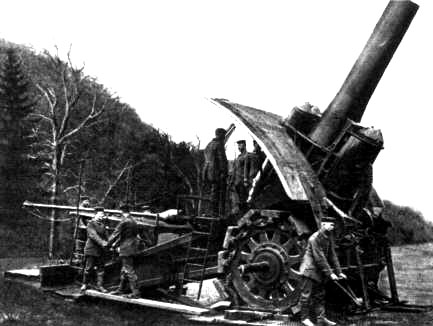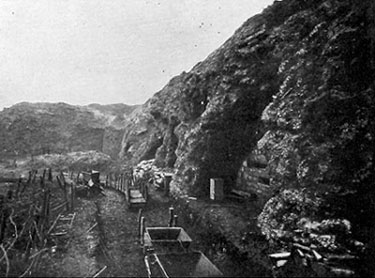The Forts of Verdun - Part 2
Back to Part One

420mm "Grosse Bertha" howitzer, aka "Fat Bertha" or "Big Bertha".
On February 25th, the Germans attacked towards Ft. Douaumont. The garrison adopted a turtle-like approach
to the onslaught. Even though giant 420mm "Big Bertha" shells
were crashing into the roof, they seem to have assumed they would not be attacked due to the fort's formidable reputation.
Only the 155mm turret was manned, firing perfunctorily on previously computed targets that had probably moved on. None of the observation domes was manned, so the enemy's approach could not be detected. The bulk of the garrison was
attending a training lecture.
Advance elements of the German 24th Brandenburg Division approached, among them a squad of about 10 pioneers (combat engineers) led by Pioneer-Sergeant Kunze. He noticed the general lack of activity around the fort, and the ill-directed nature of its firing, and decided to investigate. Peering over the edge of the fort's ditch, he saw no opposition, and proceeded to have his squad drop down into it. Once in the ditch, Kunze and
about four others were able to enter the fort through an empty revolver-cannon port by standing on the shoulders
of the other men. The Germans proceeded up the communicating
tunnel into the main part of the fort. Soon
they encountered and captured a group of four Frenchmen who had been belatedly sent to man the twin 75mm turret. They proceeded to the 155mm turret, capturing its crew as well. Leaving the others to guard the prisoners, Kunze proceeded alone towards the fort's rear exit. He came upon the lecture room with most of the
garrison in it. Reacting quickly, he slammed and bolted the room's steel door. Kunze had all but
single-handedly captured Verdun's most powerful and strategically located fortress! On the way to rejoin his
pioneers, Kunze came upon the fort's well-stocked pantry, and a cook. He then recalled that he hadn't had a
decent meal in quite some time, and may well have missed his meager soldier's breakfast that day. Covering
the cook with a pistol, Kunze sat down and ate his fill!
Soon, other groups of Brandenburgers noticed that the fort had stopped
firing. By this time, a "Big Bertha" shell had knocked down part of the ditch wall, making it easier to enter.
Two other groups entered and occupied Fort Douaumont in short order. A lieutenant leading one of these groups
wrote up a very self-serving after-action report, and for a time was hailed as the "Hero of Douaumont".
Kunze initially concealed his involvement, because he feared being disciplined for taking time out for his meal.
After the war, it was determined that a French infantry unit had arrived near the fort as the Germans that
followed Kunze were about to enter it. But the French officer
or noncom in charge ordered his men not to fire. It
appeared to him that the troops opposite were wearing "chechias", the classic headgear of French Algerian
Zouaves (like the guy on the box of rolling papers). The Germans
were actually wearing spike helmets, with the spike removed to avoid catching in vegetation. This was a classic
example of the confusion that can occur in war.

Entrance to Ft. Douaumont during the German occupation.
The German capture of Ft. Douaumont greatly assisted their further prosecution of the battle. It gave them an
invulnerable shelter for men, ammunition, and supplies, just behind the front line. Normally, French artillery fire
would have prevented the concentration of reinforcements and supplies so near the fighting. But even repeated
direct hits by the heaviest French artillery (340mm battleship-type guns and 370mm mortars) made little
impression on the fort. The Germans came to refer to the place
as "Old Uncle Douaumont".

French 340mm railway gun, dismounted from the rail car.
Elsewhere on the front, the Germans became bogged down. French
artillery on the Mort Homme was able to
enfilade them as they attacked southward on the Right Bank. The
Germans decided to concentrate their efforts
on taking the Mort Homme. This took from early March to mid-April, much longer and with many more
casualties than they had anticipated.

(Top) German burial detail, (Bottom) French soldiers at an aid station.
Verdun had become a prolonged mutual bloodletting, with little ground changing hands. Attacks and
counter-attacks by both sides were never-ending. The tempo of operations was maintained by the practice of inflating the estimates of enemy casualties. It was usually assumed that two enemy soldiers had fallen for every friendly soldier killed or wounded. Thus, both high commands assumed that they were "winning" the attrition war. In reality, both were losing.
The shelling was often so intense that even
trench lines could not be maintained in the muddy earth. Soldiers took shelter in the larger shell craters
instead. Poison gas killed all the vegetation in a large area.
General Petain, placed in command of the Verdun
sector early in the battle, attempted to alleviate the strain on the soldiers by rapid rotation of divisions in and out
of line. His concern for his troops made him the most popular general of the War. Although the front-line troops did get more rest, this also resulted in nearly 70% of the total French army
being exposed to the horrors of Verdun, while only
25% of the total German army was.
In May, disaster struck the Germans at Fort Douaumont. It is
impossible to determine exactly what happened,
but it is known that a large number of soldiers and a large quantity of ammunition of all types were inside the
fort. Possibly there was a cooking accident in a room where cans
of flamethrower oil were stored. A large
magazine explosion occurred. Nearly half the fort's upper main
tunnel collapsed, burying over four hundred
Germans. They are there to this day.
Later, the French experienced a similar horror in the Tavannes Tunnel. This was a well-protected railway tunnel
used to store supplies and ammunition. A great fire broke out
among the ammunition, and dozens of Frenchmen died.

French 370mm railway gun.
The French noticed the huge cloud of smoke that came out of Fort
Douaumont, and planned an attack to recover the fortress. This took a
few weeks to organize. 370mm guns were brought up, even though
they had never penetrated the fort. The attack temporarily captured
the rear of the fort. A machine gun was set up facing the rear doors,
and dozens of Germans were mown down as they tried to exit. But the
French were eventually driven off.
Part 3
Back to Part One
Back to The Fort Page.





